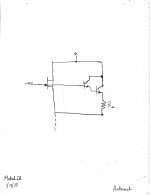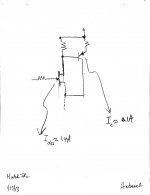Buzz, I tried your link. For shitsandgrins, I tried ZMs direct file and his was 2.5seconds!. Yours might have been 30-40 seconds.
saying he dosen't understand putors is bul#$^it. Saying it is Mac/Apple or MS is ussually BS too! Putting the file here in the best res is always better
saying he dosen't understand putors is bul#$^it. Saying it is Mac/Apple or MS is ussually BS too! Putting the file here in the best res is always better
Buzz, I tried your link. For shitsandgrins, I tried ZMs direct file and his was 2.5seconds!. Yours might have been 30-40 seconds.
saying he dosen't understand putors is bul#$^it. Saying it is Mac/Apple or MS is ussually BS too! Putting the file here in the best res is always better
Fair enough. 30-40 seconds is a ling time to wait these days. Let us know how zen pot thing works out.
Thanks. It loaded.lazy greedy boyz ...........

O.k. I got my 10R pots today, implemented.....bias and offset readjusted. I had to twist the bias up to 1.4 A because of the 0R1 resistors implemented. I did not go higher to have some security margin.
Back the Mac and the distortion program... It is so easy to adjust the distortion now, only some turns on the 10R pot of the negative side and I got 10db higher k2 than k3. Of positive phase I hope....
THD went from 0,015% (k2 and k3 on the same level) to about 0,03%. As tea-bag already mentioned, getting k2 to the wanted level, rises THD. Can anybody confirm a similar value?
Forgot, i measured all values with 8R/1W.
Back to the third room with the speakers.... Happy Nelson will have one room where he can do all.....
And sounds good, I could live with it...... !
!
Coming from F3! I was a bit disappointed some weeks ago, after all the adjustments I like the balance F6 gives to presentation. Voices and background are melted in a pleasant way. And the bass is for sure more present than with the F3.
It sounds so fine, that I do not want to look for negative phase at the moment....
I occupied a bit with Visual Analyse, a Windows distortion program, I think Botte mentioned it here.
I got very quick good results and the possibility to see even the phase of the distortion peaks is very interesting. But you have to set a threshold otherwise the phase bar is flipping from negative to positive very quickly....I am still occupied with the program......
I will report when I am sure what I am doing....
At the moment the distortion values are too low for my feeling compared to my Mac program....but the relation of peaks of k2 and k3 is at least the same. May be Botte can help a bit, with his longer experience and opinion about the rightness of distortion values.....

Back the Mac and the distortion program... It is so easy to adjust the distortion now, only some turns on the 10R pot of the negative side and I got 10db higher k2 than k3. Of positive phase I hope....
THD went from 0,015% (k2 and k3 on the same level) to about 0,03%. As tea-bag already mentioned, getting k2 to the wanted level, rises THD. Can anybody confirm a similar value?
Forgot, i measured all values with 8R/1W.
Back to the third room with the speakers.... Happy Nelson will have one room where he can do all.....
And sounds good, I could live with it......
Coming from F3! I was a bit disappointed some weeks ago, after all the adjustments I like the balance F6 gives to presentation. Voices and background are melted in a pleasant way. And the bass is for sure more present than with the F3.
It sounds so fine, that I do not want to look for negative phase at the moment....
I occupied a bit with Visual Analyse, a Windows distortion program, I think Botte mentioned it here.
I got very quick good results and the possibility to see even the phase of the distortion peaks is very interesting. But you have to set a threshold otherwise the phase bar is flipping from negative to positive very quickly....I am still occupied with the program......
I will report when I am sure what I am doing....
At the moment the distortion values are too low for my feeling compared to my Mac program....but the relation of peaks of k2 and k3 is at least the same. May be Botte can help a bit, with his longer experience and opinion about the rightness of distortion values.....
Will adding another transistor operating in parallel with R100A allows to match or mismatch the net Gm and/or internal resistance of this FET relative to the other? A proposed shematic is attached; using an NPN Darlington because its Vbe is close to the FET's Vgs.
Attachments
O.k. I got my 10R pots today, implemented.....bias and offset readjusted. I had to twist the bias up to 1.4 A because of the 0R1 resistors implemented. I did not go higher to have some security margin.
Back the Mac and the distortion program... It is so easy to adjust the distortion now, only some turns on the 10R pot of the negative side and I got 10db higher k2 than k3. Of positive phase I hope....
generg
quoting Nelson in the 6 moons audio article
"If you are interested in adjusting the harmonic structure in this amplifier, there is a nice easy place where you can do it. I have added low-value power resistors (R13 and R14) in series with the Source pins of the output transistors. Typical values for these would be 0.025Ω to 0.1Ω. If you leave R13 at 0Ω and put 0.05Ω for R14, you will find yourself with a positive-phase second harmonic. By this I mean there will be expansion as the wave goes positive and compression as the wave goes negative. If you have a negative-phase second harmonic, you could use this approach to null it out. If you leave R14 at 0Ω but set R13 at a small value, you do the opposite either creating a negative-phase second harmonic or nulling an existing positive-phase second harmonic.
The two phases of the second harmonic do sound different. In fact the most consistent observation people have reported is that positive phase has a little more projection to it, that it's a little more in your face and immediate. Negative phase tends to add more depth. This is something you can play with and moving on to the next slide, for this one we credit Patrick (EUVL) on DIYAudio. What he did was come up with a variable version. Why not put a pot on it? So here you can adjust P3 and P4 up and down, trimming the relative perfection of the symmetry, creating or nulling the second harmonic."
My take is that if you degenerate Q2 you have positive phase and if you degenerate Q1 you have negative phase. On my F6 I degenerate Q1 and to my ears am happy. When my probes arrive I will try the measurements Tea Bag
does
Best and thanks for the info
Maybe this alternate schematic too?Will adding another transistor operating in parallel with R100A allows to match or mismatch the net Gm and/or internal resistance of this FET relative to the other? A proposed shematic is attached; using an NPN Darlington because its Vbe is close to the FET's Vgs.
Attachments
Maybe this alternate schematic too?
sorry Antoinel, I cannot judge it....
Flocchini,O.k. I got my 10R pots today, implemented.....bias and offset readjusted. I had to twist the bias up to 1.4 A because of the 0R1 resistors implemented. I did not go higher to have some security margin.
Back the Mac and the distortion program... It is so easy to adjust the distortion now, only some turns on the 10R pot of the negative side and I got 10db higher k2 than k3. Of positive phase I hope....
generg
quoting Nelson in the 6 moons audio article
"If you are interested in adjusting the harmonic structure in this amplifier, there is a nice easy place where you can do it. I have added low-value power resistors (R13 and R14) in series with the Source pins of the output transistors. Typical values for these would be 0.025Ω to 0.1Ω. If you leave R13 at 0Ω and put 0.05Ω for R14, you will find yourself with a positive-phase second harmonic. By this I mean there will be expansion as the wave goes positive and compression as the wave goes negative. If you have a negative-phase second harmonic, you could use this approach to null it out. If you leave R14 at 0Ω but set R13 at a small value, you do the opposite either creating a negative-phase second harmonic or nulling an existing positive-phase second harmonic.
The two phases of the second harmonic do sound different. In fact the most consistent observation people have reported is that positive phase has a little more projection to it, that it's a little more in your face and immediate. Negative phase tends to add more depth. This is something you can play with and moving on to the next slide, for this one we credit Patrick (EUVL) on DIYAudio. What he did was come up with a variable version. Why not put a pot on it? So here you can adjust P3 and P4 up and down, trimming the relative perfection of the symmetry, creating or nulling the second harmonic."
My take is that if you degenerate Q2 you have positive phase and if you degenerate Q1 you have negative phase. On my F6 I degenerate Q1 and to my ears am happy. When my probes arrive I will try the measurements Tea Bag
does
Best and thanks for the info
What is the schematic that goes with the above?
If bottom Fet is seeing negative phase, then it means the top Fet needs higher yfs. To have higher k2 on positive phase.
@flocchini
"if you degenerate Q1 you have negative phase. On my F6 I degenerate Q1 and to my ears am happy."
interesting, you are the first one that says he likes negative phase.... one reason more to try it tomorrow.....
I suppose but do not really know the original J2 prefers negative phase too....
If I had earlier "Visual Analyser" i could have seen it possibly....
thanks
"if you degenerate Q1 you have negative phase. On my F6 I degenerate Q1 and to my ears am happy."
interesting, you are the first one that says he likes negative phase.... one reason more to try it tomorrow.....
I suppose but do not really know the original J2 prefers negative phase too....
If I had earlier "Visual Analyser" i could have seen it possibly....
thanks
- Home
- Amplifiers
- Pass Labs
- F6 Amplifier



